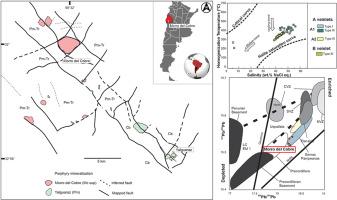Insights into the magmatic and metallogeneticevolution of the Morro del Cobre porphyry copperdeposit from fluid inclusions and lead isotope signatures
IF 1.5
4区 地球科学
Q3 GEOSCIENCES, MULTIDISCIPLINARY
引用次数: 0
Abstract
The Morro del Cobre porphyry (Cu-Mo-Au) deposit, genetically linked to the upper Miocene magmatism (∼10–9 Ma), is located over the Pampean flat-slab segment (28–33°S) in San Juan province (Argentina). The analysis of the different vein systems provided insights into the physical and chemical evolution of the hydrothermal fluids responsible for the formation of this deposit. The potassic alteration is intense to moderately penetrating in veins (A-type veins -Subtypes 1 and 2-, EB-type, and EBT-type). The fluid inclusion study determined that Type III inclusions in A1 veinlets have salinities of 40.6–56.1 wt% NaCl eq. and homogenization temperatures from 365 to 472 °C. In A2 veinlets, salinities range from 37.4 to 52.2 wt% NaCl eq., with homogenization temperatures between 343 and 472.5 °C. A transitional hypogenic mineralization stage between potassic alteration and phyllic alteration is represented by B veinlets. Type III fluid inclusions show homogenization temperatures ranging from 315.2 to 397 °C and salinities of 40.6–46.78 wt% NaCl eql. Moderate phyllic alteration is extensively distributed in the area and occurs pervasively and in D-type veinlets, overprinting the potassic alteration. A supergene alteration event is widely distributed in the area. It occurs pervasively, overprinting the potassic and phyllic alteration with an assemblage of limonite, malachite, chrysocolla, turquoise and azurite, and covellite and chalcocite replacing chalcopyrite. The Pb isotopic composition indicates a genetic relationship between the ore minerals of this deposit and the magmatism preceding the porphyry-type mineralization in the area. The mineralizing magmas of Morro del Cobre involve an older Pb from the Grenvillian basement, evidenced by the presence of medium to high-grade metamorphic xenoliths and inherited zircons. Furthermore, there is probably a Pb contribution from Gondwanic magmas, as these are the principal constituent of the Cordillera Frontal. The assimilation of fertile Gondwanan basement material by the Miocene magmatism at Morro del Cobre plays a crucial role in the formation of a productive mineral deposit.

流体包裹体和铅同位素特征对Morro del Cobre斑岩铜矿岩浆成矿演化的启示
Morro del Cobre斑岩(Cu-Mo-Au)矿床位于阿根廷圣胡安省Pampean平板段(28-33°S),与上中新世岩浆活动(~ 10-9 Ma)有遗传联系。对不同脉系的分析提供了对该矿床形成的热液流体的物理和化学演化的见解。钾质蚀变在静脉(a型静脉- 1和2亚型,eb型和ebt型)中呈强烈至中度渗透。流体包裹体研究确定A1小脉中的III型包裹体盐度为40.6 - 56.1% NaCl当量,均一温度为365 ~ 472℃。在A2小管中,盐度范围为37.4%至52.2% NaCl当量,均质温度为343至472.5℃。以B脉为代表的是钾蚀变与叶蚀变之间的过渡性低成矿阶段。III型流体包裹体均一温度为315.2 ~ 397℃,盐度为40.6 ~ 46.78 wt% NaCl eql。中度叶性蚀变在该区广泛分布,普遍发生在d型脉脉中,复盖钾化蚀变。该区广泛分布有表生蚀变事件。它普遍存在,以褐铁矿、孔雀石、黄铜矿、绿松石和蓝铜矿组合叠加钾化和绿质蚀变,并以黄铜矿和辉铜矿代替黄铜矿。铅同位素组成表明该矿床的矿石矿物与该区斑岩型成矿前的岩浆作用有成因关系。Morro del Cobre矿化岩浆中含有较老的来自Grenvillian基底的Pb,存在中高变质包体和继承的锆石。此外,冈瓦尼岩浆可能对Pb有贡献,因为它们是科迪勒拉锋面的主要组成部分。Morro del Cobre中新世岩浆活动同化了肥沃的冈瓦纳基底物质,这对高产矿床的形成起着至关重要的作用。
本文章由计算机程序翻译,如有差异,请以英文原文为准。
求助全文
约1分钟内获得全文
求助全文
来源期刊

Journal of South American Earth Sciences
地学-地球科学综合
CiteScore
3.70
自引率
22.20%
发文量
364
审稿时长
6-12 weeks
期刊介绍:
Papers must have a regional appeal and should present work of more than local significance. Research papers dealing with the regional geology of South American cratons and mobile belts, within the following research fields:
-Economic geology, metallogenesis and hydrocarbon genesis and reservoirs.
-Geophysics, geochemistry, volcanology, igneous and metamorphic petrology.
-Tectonics, neo- and seismotectonics and geodynamic modeling.
-Geomorphology, geological hazards, environmental geology, climate change in America and Antarctica, and soil research.
-Stratigraphy, sedimentology, structure and basin evolution.
-Paleontology, paleoecology, paleoclimatology and Quaternary geology.
New developments in already established regional projects and new initiatives dealing with the geology of the continent will be summarized and presented on a regular basis. Short notes, discussions, book reviews and conference and workshop reports will also be included when relevant.
 求助内容:
求助内容: 应助结果提醒方式:
应助结果提醒方式:


